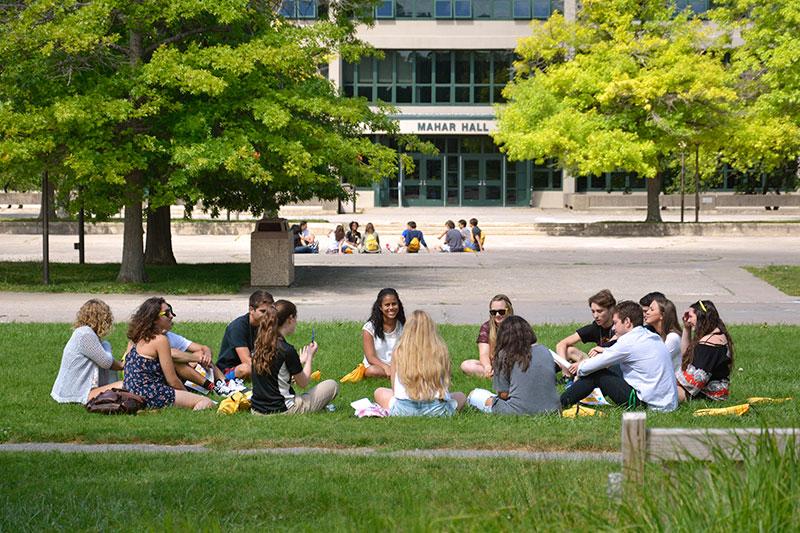An Oswego welcome—Newly enrolled freshmen with their Laker Leaders break into small groups designed to build school spirit and camaraderie during a SUNY Oswego orientation session this summer. About 1,500 freshmen are expected at the college for fall.
SUNY Oswego’s enrollment of about 1,500 first-year students for the fall semester will approach and possibly surpass 2013’s class of first-year students—the largest since 1988—and establish a new high-water mark in ethnic diversity.
“It’s an exciting time. These are changing times at SUNY Oswego, geographically, when you look at the diversity and when you look at areas of interest academically,” said Admissions Director Dan Griffin. “This is a very dynamic place in every sense of the word.”
His staff has primary responsibility for recruiting what Griffin described as a talented, well-prepared and diverse student body.
“It’s more than just attracting good applicants,” Griffin said. “I really believe that they have to come here and like what they see, and they have to envision themselves as part of this community. For that to occur, I think they need to feel welcome, they need to be able to see themselves on this campus. This campus needs to reflect society. And the numbers would indicate this is exactly what’s happening.”
Over a third of enrollees in this year’s freshman class are from groups that historically have been underrepresented at Oswego in terms of ethnicity or socioeconomic background, he said.
Among this fall’s first-year students, the most popular majors, to date, are business administration, broadcasting and mass communication, psychology and zoology. All of those programs have shown strong growth from a decade ago. While undeclared freshmen increased year-over-year, the percentage remains smaller in 2015 than in 2005.
Value recognized
Overall applications remained strong this year, near last year’s modern record of just over 11,000, and the acceptance rate has remained stable at 48 percent to 50 percent.
Griffin attributed the strong enrollment picture to the value SUNY Oswego offers students and their families. Kiplinger’s magazine and The Princeton Review both rated Oswego a 2015 Best Value College.
“I think families are more cost-conscious than ever,” he said. “The value of SUNY, and in particular of Oswego, is more apparent now than ever before. The opportunities that we provide in terms of academic experiences, facilities, on-campus living experiences, study-abroad, internships, co-ops, volunteer experiences—we’re just a tremendous value.”
SUNY Oswego offered about $5 million in merit scholarships to first-year and transfer students, in addition to the more than $80 million in need-based grants, loans, work-study and scholarship awards that Oswego students receive annually.
Griffin noted that the number of freshmen from Central New York is among the smallest to date, due to declining numbers of high school seniors. While the college anticipates enrolling about 275 freshmen from Oswego and contiguous counties this year, the number in 2001 was 526. The Office of Admissions has beefed up its recruitment in New York City and environs and anticipates about 300 freshman enrollees from the Big Apple.
Educational Opportunity Program enrollment for fall is projected to be 114, up about 30 from last year thanks to a late appropriation in the state budget. Aimed at providing access to higher education for economically disadvantaged students with strong academic potential, EOP offers an array of support services and opportunities. The program has proven its worth in retention rates and persistence to graduation, Griffin said.
The college traditionally has strived for a total enrollment of about 8,000 students—undergraduates and graduates, full and part time. More than half live on campus. Occupancy of the college’s 13 residential complexes this fall will remain at capacity of about 4,400 students.
Waterbury Hall, one of the lakeside residence halls on the shore of Lake Ontario, has reopened after a fast-track modernization and modest expansion that began in mid-December.




